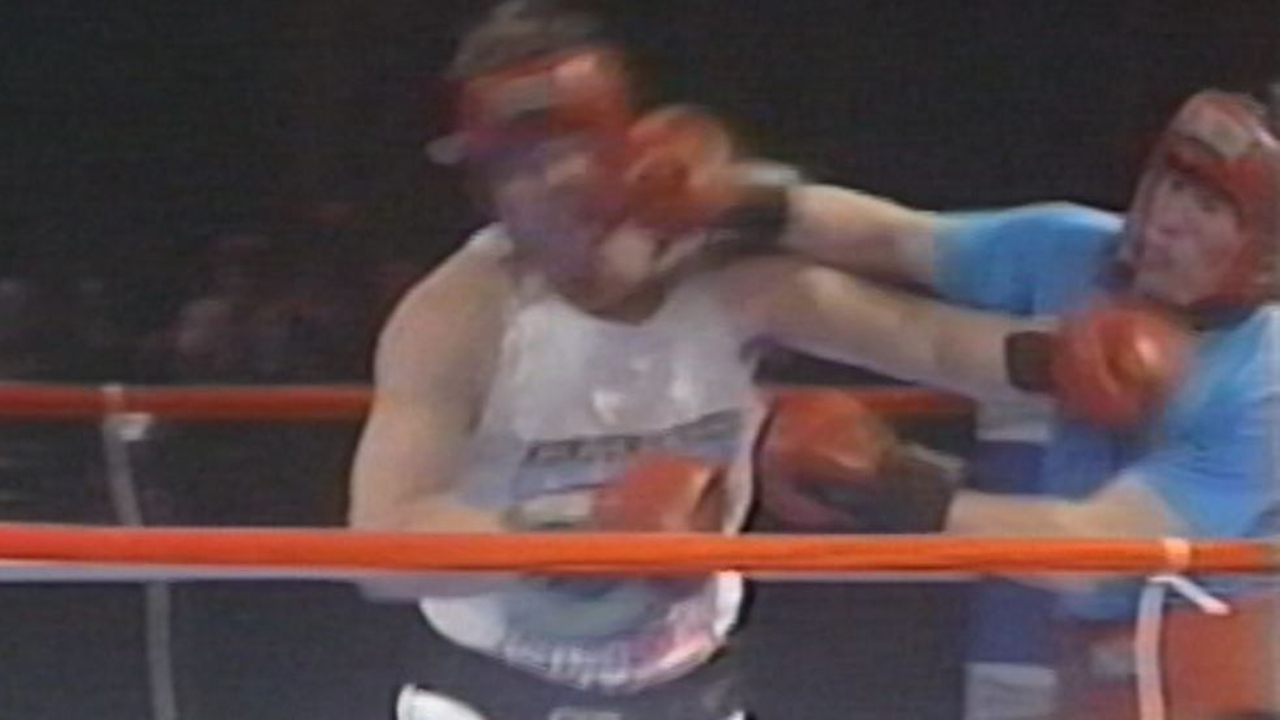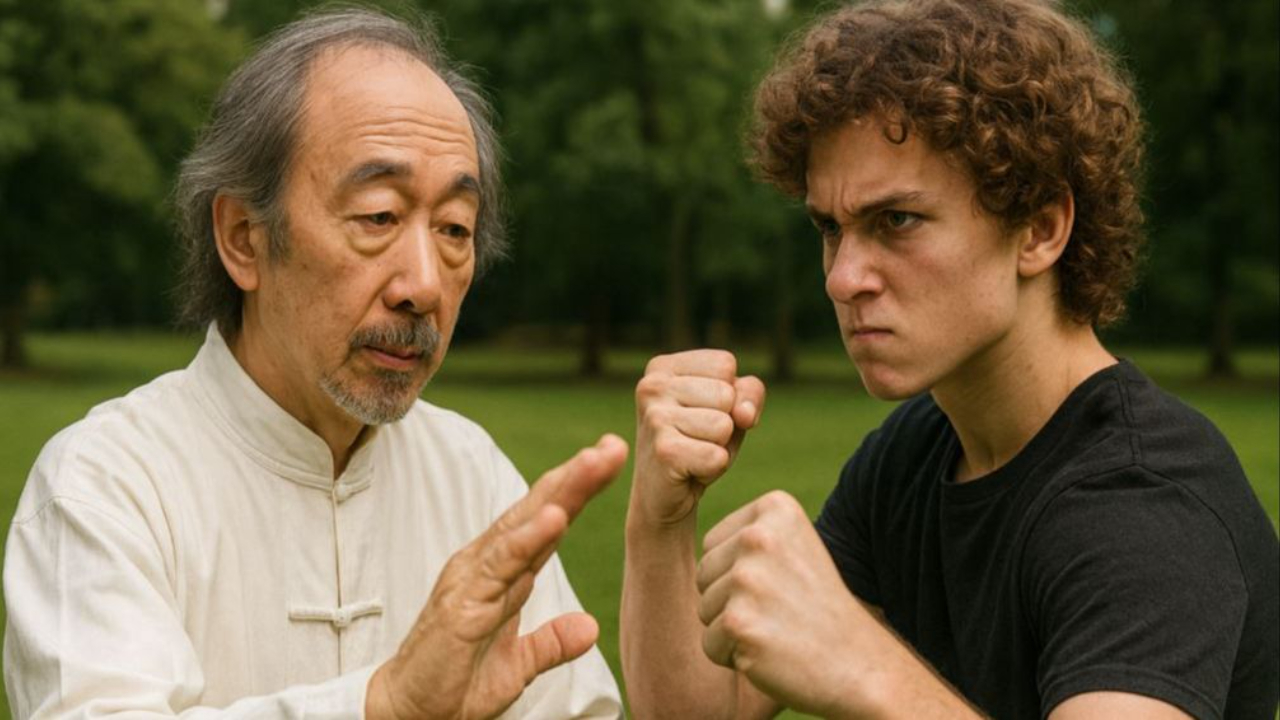Keep it Simple for Ultimate Success in Self-Defense

Close-Up Self-Defense Using Tai Chi Energies and Methods: DVD

You are in a situation where you cannot escape a fight. Someone your size or larger lunges at you, grabs you in a clinch, and tries to take you to the ground.
Can you use your Tai Chi skills to take HIM to the ground instead?
I have been working on this since 2006, when I was practicing push hands with Chen Xiaoxing in my basement and he kept putting me on the ground -- over and over again -- and he did it so easily, I could not understand what he was doing until about the tenth time I found myself on my back.
He was breaking my structure and controlling my center.
The insights from that training have driven me for the past dozen years to explore how to use the "energies" of Tai Chi (Taiji) for close-up self-defense.
How do you use ward-off, roll back, press, push, split, pluck, bump, elbow, empty, advance, withdraw in a real fight? How do you use these methods of dealing with force to take your opponent to the ground without using muscular force or "wrestling?"
My new DVD answer...
Is Your Martial Art Preparing You for Real-Life Self-Defense?

What is real-life self-defense? What is real-life self-defense with the internal arts?
Do I need to step into a ring and go full-contact these days to prove myself?
Do you?
There are suddenly a lot of keyboard warriors out there who seem to think so. Personally, I have mixed feelings about it. I have always enjoyed fighting, but as an adult, I believe it is much better to learn how to fight without getting hurt and without hurting someone else.
When my 15-year-old student was grabbed by a drunk step-father who was preparing to punch him out, my student broke the step-father's elbow with chin-na we practiced in class. That's real-life self-defense.
When my student who is a police officer took a fugitive rapist down with Pi Chuan, a Xingyi technique, he didn't ask himself during the encounter if he was using internal energy just right. He simply took down the man who was considered dangerous.
When three drunk guys at a concert wanted to fight me, I remained centered and managed...
The Perfect Image of Bagua Zhang - the Spinning Wire Ball

There are three images that summarize the three main internal arts. They are simple images and do not encompass all the subtleties but still represent good concepts.
You can think of Xingyi (Hsing-I) as a wedge driving through an opponent. A Xingyi fighter explodes through an opponent and takes his ground.
A Taiji fighter is like a beach ball being submerged into a swimming pool. The ball will take your
energy and give a bit, but there is strength underneath, and it will spring back and spin, dumping you into the water.
Bagua is like punching into a spinning wire ball. The ball catches your force and spins you off-balance, controlling your center and spinning you out in unexpected directions. It often leaves you broken by the time it spins you out.
Here is just one example. My opponent punches. I intercept the punch, wrapping my left arm
around his punching arm. At the same time, I begin spinning to his outside.
I hook his right arm and continue to spin. At this point, I ca...
A Hypothetical Conversation with a Martial Arts Student

“How long does it take to get a black belt?” asked the prospective student.
“Five seconds,” said the teacher.
“Really?”
“Yes. All I have to do is hand it to you. But it takes much longer to earn one.”
"Maybe I can earn it faster than most people."
"Well, we don't do black belts. We do sashes, and a black sash doesn't mean very much, really. We only have those because in America, people seem to need it. A black sash doesn't really mean anything."
"It means you are deadly," the student said.
The teacher laughed. "No. It means you have just begun to learn. There are a lot of black belts who know very little and can do even less."
“Oh. Well, I want to be able to use Taiji to fight.”
“Why?”
The student asked, “If I am in a bar and get attacked, will I be able to use Taiji to fight?”
“You can use Taiji to stay away from a bar where fighting may occur,” said the teacher.
“Have you ever had to use Taiji in a fight?”
“No.”
“How about Bagua or Xingyi?”
“No. I have not been in a re...
Video Highlights of New Kindle Ebook - Bagua Self-Defense

Here is a short video with highlights of some of the self-defense techniques in my new ebook - Baguazhang Self-Defense: Fighting Applications of the Cheng Style Eight Main Palms Form.
The ebook has 380 photos and descriptions of 150 self-defense applications from this one Bagua form. Each application is discussed and shown with an emphasis on internal body mechanics. The ebook costs only $6.99 and is available on Amazon's Kindle Store. Many nations have their own Amazon stores (if you are outside the US, check Amazon in your country). Here is the link to the ebook on Amazon's store in the United States.
The video was done for still photo purposes, to illustrate how each movement in the form is used for self-defense.
Two Bagua Moves to Escape an Arm Lock - Baguazhang Self Defense

Baguazhang is an internal martial art that relies on circular movement, turning, spiraling, and relaxed power similar to Taijiquan.
Many types of arm locks are used in martial arts. One of the locks that we use is sometimes called "Pat the Bull." Your opponent has you in the lock and has grabbed your shoulder to make it more firm.
In the Cheng style Baguazhang form "Eight Main Palms," two movements in the section called Grinding Palm are very useful for escaping this arm lock. The movements are called "Green Dragon Swings Its Tail" and "White Snake Twists Its Body." In the form, these movements follow each other.
Photo 6-9 shows the start of "Green Dragon Swings Its Tail." You continue to turn, stepping your right foot around into a pidgeon-toe stance, and spiral the arm upward. You continue to spin for the movement called "White Snake Turns Its Body."
When you finish, you are standing upright again.
Someone who applies force to you is often thinking in one direction. An opp...
Two Effective Ways of Critiquing Your Own Form in Any Martial Art

I am putting together my 8th Kindle ebook this week on the Cheng style Bagua 8 Main Palms Form. In working with more than 300 photos for the ebook, a couple of effective techniques have become very obvious for giving myself feedback on my own movement and posture.
Videotaping yourself is one of the best ways of seeing yourself as you are actually performing the movements. We all think we look like Chen Xiaowang or Jet Li when we are doing our forms and techniques. More often than not, we more closely resemble Jim Carrey.
I recommend shooting video as you are performing a form at fast speed, then perform it at a slower pace. Both times, be as specific as you can on precision, power, and body mechanics. Then watch the video. Run it normally and then in slo-mo if you can. Ask yourself if your structure is sound, if your stances and stepping is right, if the timing of your hand movements is right -- there are a dozen things you cou...
Tai Chi Ebook - Self-Defense Using the Chen 19 Form

I have written an ebook with 239 photos and detailed instruction for 106 self-defense applications that are found in the short Chen Taiji 19 Form. The ebook is titled Chen Taiji Self-Defense - Fighting Applications from the Chen Family Tai Chi 19 Form. It is available on the Amazon Kindle store for $4.99 and will play on any device with the free Kindle app installed.
The Chen 19 Form was designed by Chen Xiaowang in 1995. He was asked by students around the world for a shorter form to fit into their busy daily lives. Also, in my opinion, I believe he wanted to provide a Chen family answer to the Simplified Yang 24 Form that has become the most popular Tai Chi form in the world.
The Chen 19 Form takes about 5 to 6 minutes to perform if done slowly -- less time if you do it with power and speed. It is based primarily on the longer form, Laojia Yilu. Movements are a bit conservative, with less obvious silk-reeling, than the Chen 38 or Xinjia forms. This is the first form that I teach...
The Difference Between Fighting and Practicing a Martial Art

I received an interesting email from a website member in the United Kingdom. It started as a discussion about Hsing-I and the relationship of the Five Fist Postures to the 12 Animals. It went on from there to discuss the evolution of fighting movements into art.
In our 21st Century, MMA-obsessed culture, traditional arts are often criticized or brushed off as ineffective. That's pure B.S. of course, another one of those "my style is better than your style" type of arguments.
These are called martial "arts" for a reason. The styles that I study are internal martial "arts." The movements in Hsing-I, Tai Chi and Bagua can be used for fighting, but the word "art" is part of the name. Over the past 40 years of practicing, the reason has become more clear to me.
Let's look at a movement in the Bagua Swimming Body form called "Black Dragon Slashes Its Tail." It's part of the 3rd section of the form. I just put a long video lesson up on the website last week with detailed instruction. ...
